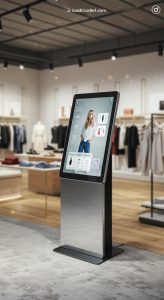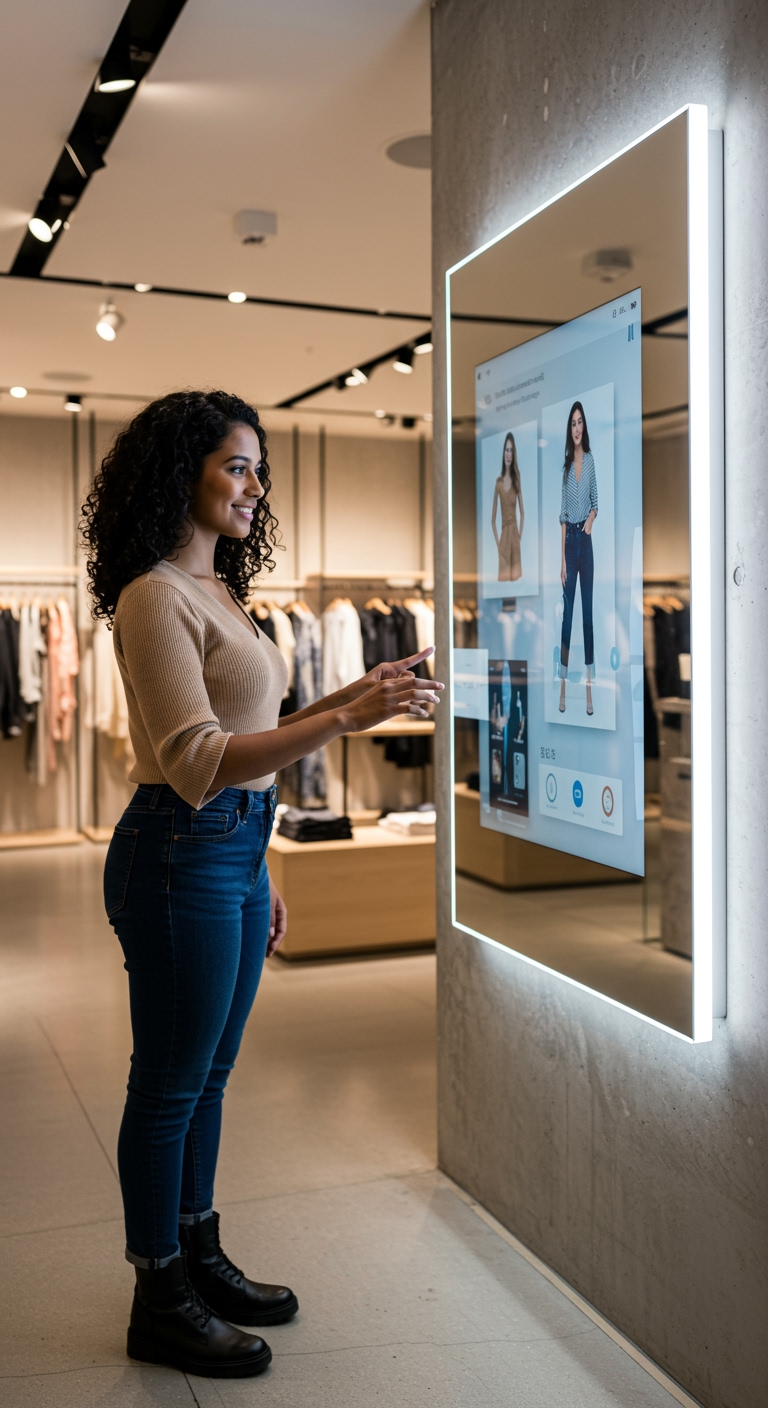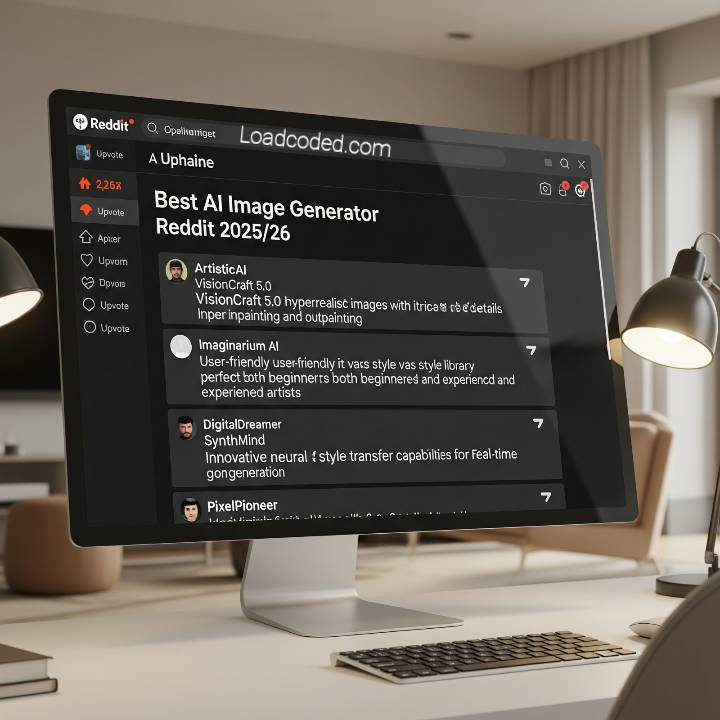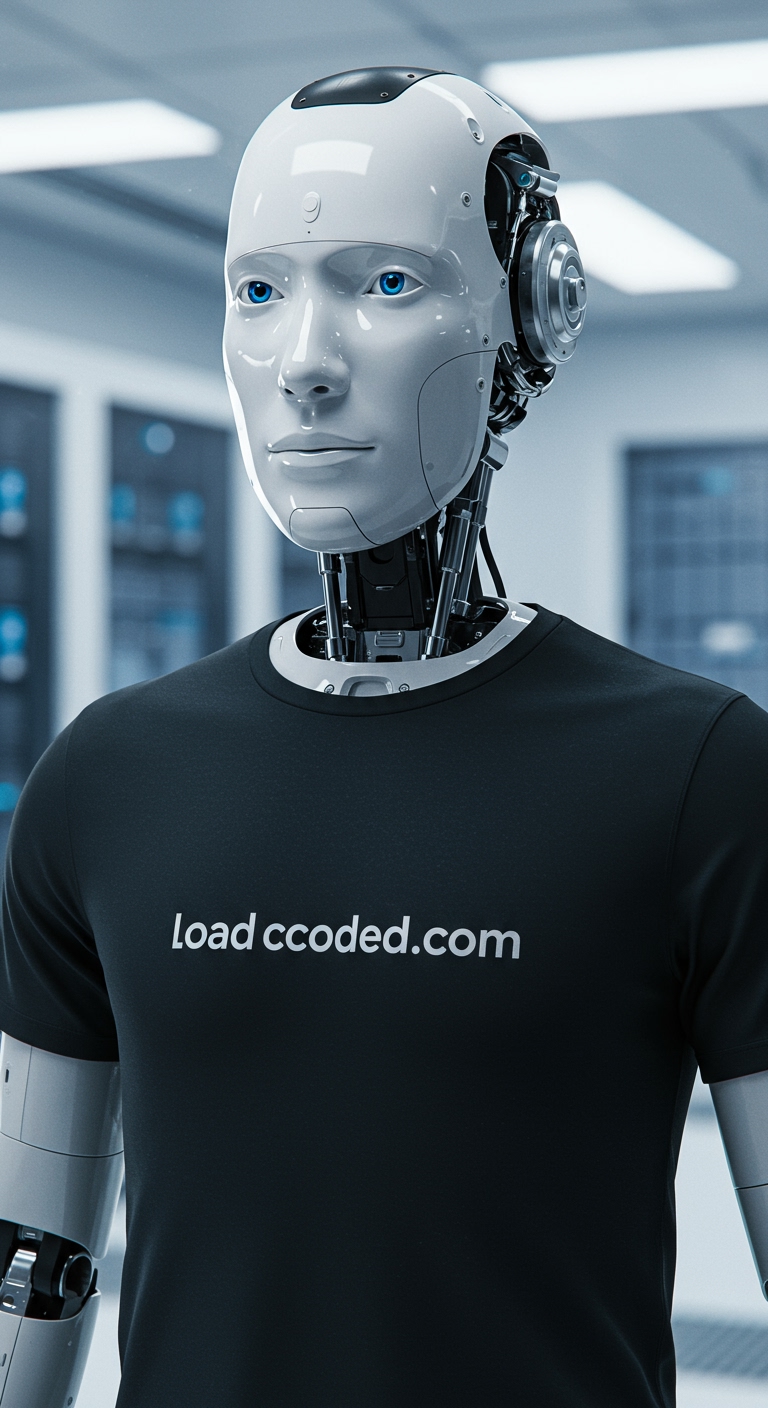Check-Out How Smart Mirrors are Transforming In-Store Experiences
Check-Out How Smart Mirrors are Transforming In-Store Experiences, Discover how smart mirrors (augmented “virtual mirrors”) are revolutionizing retail by overlaying digital try-ons and personalized info onto a shopper’s reflection, creating a seamless, futuristic in-store experience.
Smart mirrors (aka “magic mirrors”) are redefining the brick-and-mortar shopping experience by blending physical and digital worlds. These devices look like ordinary mirrors but use AI and AR to overlay information (like virtual clothes, product details or even weather) onto your reflection. They are growing rapidly – for example, a recent report noted the global smart mirror market grew from about $2.82 billion in 2022 to $3.28 billion in 2023, and is on track to nearly double in the next few years. In this post, we’ll explain what smart mirrors are, how the underlying technology works, and why retailers (and shoppers) stand to gain.
What is a smart mirror?
A smart mirror (or virtual mirror) is essentially a reflective display that shows your image plus digital content. In practice, it’s a screen behind a two-way mirror that runs software to recognize the user and project augmented-reality overlays onto the reflection. For example, a clothing smart mirror can let you “try on” outfits you aren’t wearing by superimposing virtual garments over your reflection. According to Wikipedia, virtual mirrors are used in-store to “show people how an item of makeup, clothing, handbag or accessory might look on them,” and can also deliver product info or promotions. In short, a smart mirror replaces or supplements the normal mirror view with interactive, context-sensitive visuals and data about products or services. It may be voice- or touch-controlled, and often connects to the Internet to fetch the latest info (news, weather, store inventory, etc.) as you shop.
Where is the magic? (A few words about technology)
The “magic” behind smart mirrors is a combination of augmented reality (AR), computer vision, and IoT connectivity. Behind the reflective glass is a camera (or depth sensor) and a display panel. Using computer vision and AI, the mirror detects the user’s body, face, or gestures and aligns virtual images onto the live camera feed. For example, it can track your face and overlay virtual makeup or jewelry, or map your full body and render clothes on top of your reflection.
These mirrors are connected (via Wi-Fi/Bluetooth) to cloud services that run the AI/AR software. They may use advanced machine learning to personalize suggestions: for instance, recognizing repeat customers or analyzing skin tone and body shape to recommend products. SAP notes that a smart mirror uses VR/AR to let customers “virtually try on different styles and sizes” of clothing, get outfit suggestions, or even display store information like pricing and stock levels. In practice, setting one up typically involves a two-way mirror sheet, an LCD or OLED screen behind it, and cameras or motion sensors. The system fuses the mirror’s camera feed with 3D graphics in real time, making it appear the digital items are part of your reflection. The result is an immersive, interactive fitting-room or point-of-sale display powered by AI and AR.
How do smart mirrors change the user experience?

Smart mirrors make in-store shopping more convenient, personalized, and engaging. For shoppers, they bring the ease of online browsing into the physical store. Instead of fumbling with racks or dirty sample products, you can virtually try on dozens of outfits or makeup looks in seconds. Many smart mirrors provide virtual try-on: they capture your image and superimpose clothes, hats, glasses, or cosmetics on you in real time. You simply stand in front of the mirror and use hand gestures or voice commands to change the styles you’re “wearing.” This reduces the need to physically undress and redress in a fitting room, saving time and improving hygiene.
At the same time, smart mirrors add a layer of personalization. They can pull up your past purchases or saved preferences (if you log in or scan a code) to suggest items you might like. For example, a smart mirror could recommend a handbag that complements the dress you’re trying on, or suggest sunglasses based on the weather forecast. A recent review noted that by adding AR try-on, shopping becomes “a journey” with styling tips – picture a mirror that not only shows you in a jacket, but also overlays advice like “Try this jacket in blue” or “Pair with these boots for a complete look”.
Smart mirrors also shorten the path to purchase. They often integrate with the store’s inventory system: you can tap the screen to see if your size or favorite color is in stock, or even place the item in a cart without waiting in line. In one pilot at H&M’s COS store, smart mirrors recognized the exact garment (by RFID tag) that a customer brought into the fitting room and immediately offered styling recommendations and the option to request a different size or color. In effect, they give customers instant access to a virtual shopping assistant. Because shoppers can swipe through products virtually and checkout on the mirror, the experience can feel as seamless as online shopping — but with the fun of a high-tech, interactive fitting room. Overall, by blending the engagement of AR with retail, smart mirrors make shopping both more efficient and more entertaining.
Smart mirror examples in practice
- H&M (COS store, Beverly Hills) – H&M Group piloted smart mirrors in its COS stores that identify the clothing items customers bring into the fitting room and provide outfit recommendations. In this program, mirrors let shoppers take a “fashion magazine cover” selfie (dubbed “Instafame”) and then scan a QR code to download and share it on social media. The system, built with Microsoft Azure and voice commands, also suggests accessories and alternative styles. The campaign saw high engagement: 86% of shoppers who took the selfie scanned the QR code to share the image, and 10% signed up for marketing emails. In short, H&M used smart mirrors to make trying on clothes more fun and to capture marketing leads.
- Wella (Beauty salons) – Wella Professionals implemented a salon-grade smart mirror (powered by its CareOS platform) for hair try-ons. This mirror shows customers a live 360° video of themselves while digitally testing hair colors and styles in real time. It even uses facial recognition to compare before-and-after looks. The touchless interface responds to hand gestures, so users can experiment hands-free. This lets clients visualize complex treatments (like a dramatic new hair color) before committing, improving satisfaction with beauty services.
- Adidas (London Oxford Street store) – Adidas outfitted its flagship with smart fitting-room mirrors. These mirrors detect each item brought in and display product info on the mirror surface. For example, a yellow jacket will appear in the mirror with its details and alternative sizes/colors (see image). Shoppers can also virtually “place” their outfit in different environments (using green-screen effects) and instantly share looks on Instagram. (Watch this video of the Adidas smart-mirror installation.) The interface even offers buttons like “Try a different size” or “Call an associate,” streamlining the in-store service process.
4. Nike (Smart fitting rooms) – Nike stores have introduced smart mirrors that display clothing items on the customer and allow customization. For instance, a customer could virtually change the color or pattern of a pair of shoes on the spot. These mirrors also suggest complementary products (shoes that match a chosen shirt, etc.) before purchase. The goal is to give Nike shoppers an immersive trial experience without altering what they physically wear.
- Neiman Marcus (Memory Mirrors) – Neiman Marcus developed its “Memory Mirror” system for high-end clothing. These mirrors let customers digitally try on multiple outfits and compare them side-by-side on screen, so they can easily choose a favorite without changing clothes physically. The mirror “remembers” which outfits were viewed together, essentially functioning as a virtual try-on diary.
- Sephora (Beauty AR mirrors) – Beauty retailers are leaders in smart mirror tech. Sephora’s stores feature AR “makeup mirrors” (powered by ModiFace) that let customers test hundreds of lipstick or eyeshadow shades in real time. Shoppers simply lean in and tap a color palette on the mirror interface, and the chosen cosmetics are applied digitally to their reflection. This not only speeds up sampling (no need to physically apply and remove products) but also doubles sales: one report notes Sephora saw ~31% sales increase from AR mirror trials, while other brands like Estée Lauder and Clinique reported big gains in conversion and basket size using similar AR try-on tools. In other words, these mirrors turn makeup shopping into a risk-free “try before you buy” experience.
- Ralph Lauren (Interactive dressing rooms) – At Ralph Lauren’s flagship, smart mirrors with RFID scanning recognize what customers bring into the room. The mirror then shows other available sizes and colors for that garment, recommends matching accessories, and even has a “Call an Associate” button so the shopper can request assistance without leaving the fitting room. This keeps the try-on momentum going and improves service: before smart mirrors, customers had to shout for help or stand up, but now everything is at their fingertips. In trials, Ralph Lauren saw a 90% engagement rate with these smart dressing-room features within the first months.
Win-win: the benefits of smart mirrors
Smart mirrors create a win-win for customers and retailers. For shoppers, they offer a unique blend of efficiency and entertainment. Trying on clothes or makeup becomes almost instantaneous, reducing queues and fitting-room hassles. Shoppers also enjoy a more engaging experience – the novelty of AR and instant sharing options turns routine shopping into something fun and social. Indeed, when customers can virtually “play” with products and post their experiences (selfies with new outfits or filters), they become brand advocates by sharing on social media.
Retailers benefit through higher engagement and sales. Studies and case reports consistently show AR mirrors raise purchase confidence and conversion rates. For example, AR-enabled trials make customers more likely to buy and buy more. Smart mirrors let retailers personalize each visit: they can push tailored promotions, collect email leads (as H&M did with its QR campaign), and gather data on shopper preferences in real time. According to Netguru, these devices help stores “achieve key objectives” like boosting loyalty and showing more products than can fit on a rack.
On the operations side, smart mirrors can streamline retail staffing. They reduce the load on sales associates (customers self-serve recommendations) and optimize inventory – the mirror knows what styles are popular or out of stock and can automatically update the store’s online platform. All of this drives sales efficiency and reduces wasted effort.
That said, there are considerations: outfitting a store with high-tech mirrors is expensive, and customers may have privacy concerns about cameras in dressing rooms. Retailers must address data security and be transparent about what information is collected. But overall, the returns — from higher sales and customer satisfaction — can make smart mirrors a compelling investment in modern retail.
Future of the shopping experience
The future of retail is increasingly immersive and connected, and smart mirrors are a harbinger of what’s to come. As online shopping grows, brick-and-mortar stores are reimagining themselves as experiential venues. Experts predict the line between physical and virtual will blur: imagine stores where mirrors suggest personalized outfits as soon as you walk in, or fitting rooms that change lighting and scenery to match your mood.
AR and AI will expand beyond mirrors to augment the whole store. For example, one can envision smart shelves that communicate with your phone, AR glasses that provide product info as you browse, or entire dressing rooms that simulate different environments. Already, a large share of consumers report they prefer retailers with AR experiences — nearly 75% in one survey. Stores of tomorrow will likely have digital assistants at every touchpoint: voice-enabled kiosks, interactive digital signage, and perhaps mobile apps that seamlessly link with in-store AR.
Some companies are racing ahead. SAP notes that future stores might include “Just Walk Out” checkouts, VR showrooms, and even delivery drones from the store. Others are experimenting with pop-up shops where AR fashion shows or holographic try-ons happen on the spot. The goal is clear: give customers a reason to come in-person by offering what online alone cannot – novelty, experience, and instant gratification. In short, smart mirrors are one step toward a future where shopping is not just a chore, but an engaging tech-driven adventure. For more on this trend, see Wikipedia’s Virtual mirror page, which discusses how retailers use these devices to simulate outfit try-ons and enrich the in-store experience.
Frequently Asked Questions
- What exactly is a smart mirror? A smart (or virtual) mirror is a display behind glass that shows your reflection augmented with digital content. It uses cameras and AR so you can virtually try on products (like clothes or makeup) or see information about them as you shop. Essentially, it’s an interactive mirror with Internet and AI capabilities.
- How do smart mirrors work in a store? They combine hardware (touchscreen/display, cameras, sensors) with software (AR, AI). The camera captures your image and computer-vision software maps your body or face. The mirror’s AR engine then overlays 3D graphics (e.g. clothing, makeup) onto the live video of you. Some use RFID or vision to detect items you hold or wear. All of this happens in real time – the mirror updates instantly as you move or change selections.
- What are the main benefits for shoppers? Customers can avoid crowded fitting rooms and unsanitary testers by virtually sampling items. Smart mirrors speed up decision-making (no hunting for sizes or grabbing an associate’s attention) and provide personalized style advice on the spot. They also make shopping more fun and social – users often share their “magic mirror” selfies online.
- How do retailers benefit from smart mirrors? Retailers see higher engagement and sales. The interactive technology draws in tech-savvy customers and often leads to more impulse purchases. Mirrors can capture customer data (preferences, sizes, styles tried) to improve inventory and marketing. They also help staff assist multiple shoppers at once – for example, an associate can drop additional items to a fitting room on request from the mirror’s interface.
- Are smart mirrors only used in fashion and beauty? No. While apparel and cosmetics are leading adopters, smart mirrors are branching into fitness (mirrors that guide workouts or track form), home décor (showing how a paint color or sofa fits in your room), and even hospitality (hotel room mirrors playing news or controlling devices). Any setting that benefits from visual “try before you buy” or personalized information can use this technology.
- What is the future of smart mirrors? Expect continued advances in AI and AR. Future smart mirrors may integrate with your smartphone or smart home, use 3D body scans for perfect clothing fit, or enable virtual shopping parties with friends. According to industry analysts, as much as 61% of shoppers say they prefer retailers offering AR, and they’d visit more often if they did. We’ll likely see more stores adopting these systems, and the technology improving in realism and ease of use. Ultimately, smart mirrors are just one element of a growing trend to make in-store shopping as convenient and entertaining as online.
Summary
In summary, smart mirrors are transforming in-store retail by merging augmented reality and data with traditional shopping. They let customers try on clothes, makeup, and accessories virtually; get instant style recommendations; and interact with products in a high-tech way. Retailers benefit from increased customer engagement, higher conversion rates, and valuable data insights. Real-world deployments – from H&M’s fashion selfies to Sephora’s virtual makeup try-ons – have shown concrete success (notably sales lifts and consumer buzz). As the technology matures, we can expect to see smart mirrors become commonplace in stores, turning shopping trips into personalized, interactive experiences. With AR and AI at the helm, the future store will seamlessly blend the physical and digital, making every fitting room and sales floor smart, responsive, and delightfully efficient.











